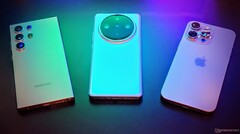
The Galaxy S24 Ultra, iPhone 15 Pro Max and Vivo X100 Pro are three of the most powerful smartphones on the market right now thanks to their incredible chipsets. We put them to the test in a straight up head-to-head shootout under the same conditions to see which comes out on top.
We’ve got our hands on the iPhone 15 Pro Max, Galaxy S24 Ultra and Vivo X100 Pro, all three titans of the flagship phone class and running the three most powerful smartphone chipsets on the market right now.
The iPhone 15 Pro Max runs the custom Apple A17 Pro with a hexa-core clocked up to 3.77GHz and features an all-new 6-core GPU architecture. The Galaxy S24 Ultra runs the Qualcomm Snapdragon 8 Gen 3 (SD8G3) with a classic big.LITTLE octa-core configuration clocked up to 3.4GHz with a Adreno 750 GPU that clocks up to 1GHz. The Vivo X100 Pro runs the MediaTek Dimensity 9300 (D9300) chips with an unconventional ‘all big’ octa-core arch clocked up to 3.25 GHz with 4 large cores and 4 mid cores. Its Mali G720-Immortalis sports a 12-core configuration.
Naturally, getting these devices and chips in hand, we wanted to see how they compare performance-wise in a quick-fire head-to-head test of their CPUs and GPUs under the same conditions. To this extent, we took a measure of the room ambient temperature and the temperature of each device on its rear using an infrared heat sensing gun before and after each run. All devices were tested under the same ambient temperature and at the same time, giving us a good indication of thermal management which adds additional context to their respective scores. This is a much fairer way of comparing performance.
As you would expect, we tested the CPUs with Geekbench 6, which has a revised workload of real-world tasks that smartphone users increasingly run on their devices, including machine learning tasks related to photography and language models. To test the GPU, we subjected them to the Wild Life Extreme Stress Test, which runs a graphics intensive workload looped over a 20-minute period, recording the best loop score, and the lowest as the chip starts to heat up and throttle. It tells us a lot about the device’s thermal management as well as the ability of each chip’s sustained performance.
Geekbench 6:
In assessing the performance of the chips in Geekbench 6, you can see from the table that the iPhone’s A17 Pro chip has a solid 30+% percent lead in single-core performance over both the Galaxy’s SD8G3 and the Vivo’s D9300. This is generally considered the most important metric as most mobile apps still only utilize a single core. However, for more complex tasks, multi-core performance becomes more important, particularly for machine learning tasks in photo apps or gaming, for example. In this case, the D9300 is basically on par with the A17 Pro while the SD8G3 trails by around just 7%.
This would have been unheard of only a year or two ago, so it seems the performance gap between Apple’s vaunted chips and the competition is closing considerably. Early benchmarks for the SD8G4 and D9400 due later this year are also very promising, with Apple’s performance crown looking as though it could be toppled unless it is cooking up something special with the A18 Pro in response. In terms of thermal performance during Geekbench 6, they remained well under control for all the chipsets, although the D9300 got slightly toastier – keeping in mind that Geekbench 6 is not a stress test.
3D Mark Wild Life Extreme Stress Test:
The 3D Mark Wild Life Extreme Stress Test was conducted in the same room at the same time with the same ambient temperature of 26-degrees Celsius (78.8 F) and screen brightness set to 50%. It reveals, once again, that Apple has a serious fight on its hands.
The SD8G3 and D9300 both outperform the A17 Pro by a considerable margin in peak performance, although the iPhone’s lowest boot loop score was highest. The iPhone’s overall frame rate range was also on par with the SD8G3. Importantly, the iPhone’s stability was also the highest at 61.4%, around 10% higher than the other two chips. This is potentially a benefit of its TSMC 3nm fabrication and despite the fact that it only leans on basic graphite sheeting for a thermal solution. It also suggests that the overheating issues faced by the iPhone 15 Pro at launch have finally been banished.
Externally, the Vivo/D9300 ran hottest at 44-degrees Celsius (111.2 F), while both the SD8G3 and A17 Pro stayed just below 40-degrees Celsius (104 F). While the Vivo X100 Pro has a vapor chamber, Samsung has fitted the Galaxy S24 Ultra with a vapor chamber that is 92% larger than it fitted to the S23 Ultra. The SD8G3 drew slightly more juice losing 9% of its charge over the 20m test, with the A17 Pro and D9300 dropping just 7% of their charge each.
Conclusion:
All of these phones will power through the tasks for power users and regular users alike. Any of these phones will also offer excellent mobile gaming performance as well, with little to separate them overall. The A17 Pro takes the overall CPU performance gong, while the SD8G3 and D9300 share the honors on the GPU side in terms of outright performance.
As we recently highlighted exclusively, however, the A17 Pro also benefits from AMD’s FidelityFX Super Resolution upscaling, an open source technology that Apple has built into its MetalFX framework. Even though both the SD8G3 and D9300 may have more graphics horsepower, the A17 Pro will be able to punch above its weight in demanding gaming titles like Resident Evil Village and Death Stranding that have recently made it to the platform as iOS exclusives at this time.
What these tests also demonstrate is that, when combined with their NPUs for machine learning acceleration, the CPU and GPU performance of these chips working in unison will be able to handle more AI tasks on-device than say chips like the Tensor G3, which have to off-load many of the Pixel 8 Pro’s latest generative AI tasks to the cloud for processing. This reduces privacy, increases latency and drains more battery, which is a real benefit of offering the powerhouse performance that all these smartphones and their chips deliver. Benchmarks matter now more than ever before.
*Note: While we did run the Geekbench ML test, which targets the NPU, we weren’t confident in the results it was producing for the SD8G3, and will contact Primate Labs to better understand what might be going on before publishing them.

Sanjiv Sathiah – Senior Tech Writer – 1446 articles published on Notebookcheck since 2017
I have been writing about consumer technology over the past ten years, previously with the former MacNN and Electronista, and now Notebookcheck since 2017. My first computer was an Apple ][c and this sparked a passion for Apple, but also technology in general. In the past decade, I’ve become increasingly platform agnostic and love to get my hands on and explore as much technology as I can get my hand on. Whether it is Windows, Mac, iOS, Android, Linux, Nintendo, Xbox, or PlayStation, each has plenty to offer and has given me great joy exploring them all. I was drawn to writing about tech because I love learning about the latest devices and also sharing whatever insights my experience can bring to the site and its readership.
